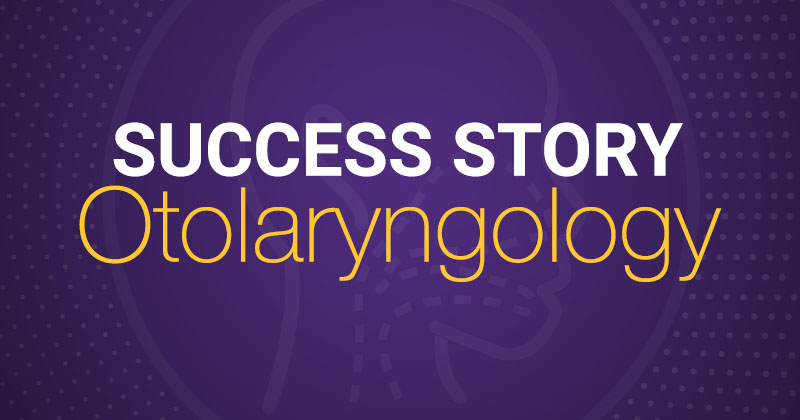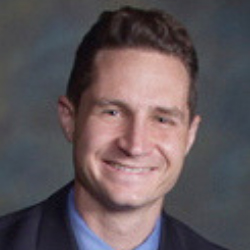Dr. David Lehman Sees a “Paradigm Shift” With the Otolaryngology EHR System EMA™

Case Study

The Goals
- Select an ENT electronic health record (EHR) system
- Create notes more efficiently during exam
- Eliminate time spent creating templates
- Enhance physician-patient relationship during exam
Key Benefits Experienced
- Specialty-specific EHR system for otolaryngologists
- Faster, streamlined note-taking
- Automated suggested coding
- Cost-effective, cloud-based convenience
Modernizing Medicine’s Senior Medical Director of Otolaryngology shares his EHR story.

“I think the biggest obstacle holding doctors back from moving to better systems is simply the fear of change. I’m thankful to have EMA. It’s the ENT software system I wished I had for seven years. I see where the future of EHR systems has to be to help doctors save time and document and code more accurately. EMA is it.”
‒ DAVID LEHMAN, MD*
Designed for ENT Doctors
Frustrated with the available EHR systems on the market, Dr. Lehman knew there had to be a better solution, one with deep domain knowledge and unique functionality just for ENT doctors. “I became involved with Modernizing Medicine’s ENT EHR system, EMA, and saw that it was a huge paradigm shift,” said Dr. Lehman. “EMA was designed specifically for the otolaryngologist, created from the ground up to consider only what that specialty needs. It has otolaryngology-specific medical knowledge and diagnoses built directly into the system. As a result, I can move through an exam faster and my notes are much more detailed and accurate.”
Documentation Made for Otolaryngology
EHR systems commonly rely on templates that don’t provide the detail or breadth of information needed to document an exam effectively. “Having used other systems, I was never satisfied with templates, as they weren’t tailored to the specific medical conditions I treat as an ENT doctor. I tried to write my own templates for a while, but the language didn’t flow and they were cumbersome to generate. A few years ago, I finally stopped using a template and free typed instead. My patients used to comment that I was a fast typist, and I knew I had to be just to capture all of the information.”
Switching to the ENT EHR, EMA, freed Dr. Lehman from typing and made capturing all of the exam information easy, especially using the touch-based iPad interface. “EMA has streamlined my note-taking tremendously,” said Dr. Lehman. “The exam set is tailor-made for me as an otolaryngologist and I no longer need to fit general findings into an ENT exam. EMA describes the findings as I think of them as a head and neck surgeon. That really carries across all aspects of the system. The plans are customized for each individual diagnosis, and designed in a way that ENT doctors think.”
An Operative Note in 10 Seconds
Not only does EMA eliminate the need for extensive typing so that Dr. Lehman can focus more on his patients, it enables faster creation of notes. “One of the biggest timesavers for me has been the ease-of-use of the procedure notes,” he said. “In my old EHR system, there was no way to easily generate procedure notes. Even though I might have done 20-25 scopes per day, I still had to type the same note over and over. I could cut and paste from one to another, but I’d run the risk of cloning notes and having inaccurate information. I didn’t want to do that, so I typed out each note individually. It got even more difficult when I looked at more complex procedures with multiple steps. With EMA, I can generate an operative note, including every step I’ve done, in about 10 seconds. I see 30-40 patients per day, so it’s a huge time-savings.”
Prior to EMA, Dr. Lehman had to lug a laptop around from room to room and use it to document during the patient visits. That slowed down his exams and was a barrier to patient interaction. “I’m so glad that I don’t have to do that anymore,” Dr. Lehman said. “With EMA, I document on the iPad EHR. Because the device is so small, I’m able to maintain eye contact with my patients during the exam, which gives them a better experience. My patients are really impressed when they see me documenting on an iPad. They feel that the iPad is state-of-the-art technology and figure that I must be on the cutting edge with medicine too.”
Helps With Coding Confidence
“Before EMA, I was less confident in my coding, so I coded everything a level three because it was safe. I just didn’t feel that I had the documentation to support a higher level of coding. EMA automatically suggests codes for the procedures I do. Now I don’t have to hesitate when billing the level fours that I deserve, since the documentation is there to support it. Also, if I select the wrong code, I may be denied payment. EMA suggests the ICD-10 code based on a smart coding algorithm – diagnostic details and laterality are taken into account – saving a tremendous amount of time and helping to avoid uncertainty,” he explained. “I don’t even want to calculate how much revenue and time I lost over the years by using another EHR system.”
Cloud EHR for Greater Convenience And Savings
Dr. Lehman laments the downside of an on-site system. The hardware and tech support needed to manage the servers for an older, client-server-based EHR system can result in slow data transfer, overloaded servers and staff needed to troubleshoot issues or maintain the system.
“Moving to the cloud just makes good business sense,” said Dr. Lehman. “A doctor can access patient information wherever and whenever he needs it. Plus, if you need a dedicated staff member to maintain the system, that’s not a revenue-generating position. It takes away from the bottom line.”
With EMA, physicians don’t have to worry about aging servers, updating the ENT software or figuring out how to support them. “The fact that EMA is cloud-based is a big benefit and can free a practice from in-house technology headaches and added costs,” Dr. Lehman said.